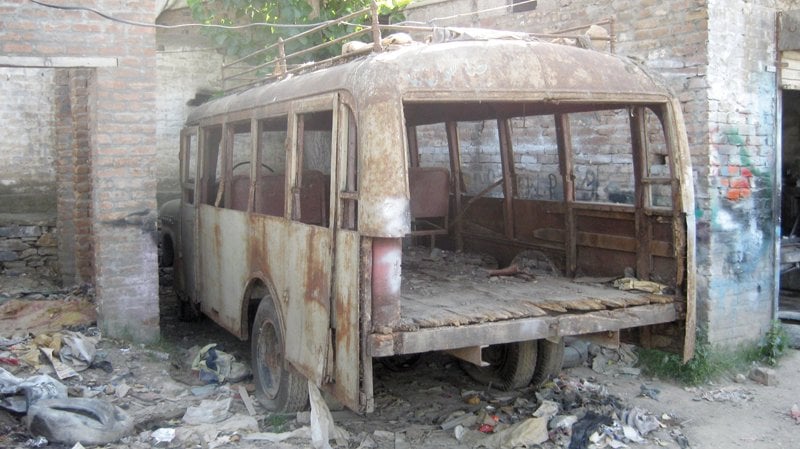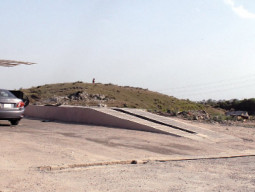
SWAT: Expensive fabric rustles inside as the chauffeur opens the door in one elegant swoop and stands tall outside. Eventually a well-shod foot emerges from a gleaming royal carriage. Those outside have no privilege to peek inside but imagine luxurious seats, a rich colour palette and technology yet afforded by few of the public.
That’s how one imagines the fascination associated with royalty and their doings. Fast foward to Swat today and one look at the bus which used to carry the stately women of the valley only evokes images of a scrap yard and tetanus.

However hard it might be to banish its current state from mind, as the grandson of the Wali of Swat walks The Express Tribune through the grandeur associated with the royal bus, it becomes easier to cloak the derelict structure in the rich fabric of history.
Mian Gul Umer Farooq shares that his grandfather, then Wali of Swat, imported the frame of the coach from the USA in 1960 – a Chevrolet. A car once favoured by government officials and dignitaries in Pakistan alongside the popular Cadillac.
It was then assembled to befit the local bluebloods. Wood was used in the body so to suit the weather of the valley and it was all put together by local mechanics.
“The movement of the royalties was an occasion. Residents of the valley would line the sides of the road to see the bus and its occupants,” says Farooq.
But now, that wonder associated with lineage and rulers has receded into rust-riddled history which preserves nothing. The archaeology department or officials of the culture ministry have not made any efforts to preserve Swat’s heritage.
When Farooq saw the bus two months ago, standing in a government garage, he was taken aback with sorrow – the carriage was after all a symbol of his grandfather and great grandfather’s times.
“I asked the district authorities to handover the vehicle into my custody. Then I took it to a workshop in Saidu Sharif where it is still being worked on.” He says he will do everything in his power to preserve his own history and an asset of the valley.
“When the bus came into my custody, it didn’t have an engine and some other parts. I had to buy a new engine for Rs150,000.”
The Wali’s fleet
The bus was in royal service for five years, shares the Wali of Swat’s grandchild. “It was used to transport noble women to areas like Malakand and Musa Maina and would also take their children to Aitchison College.”
He points out since Swat was a welfare state, his grandfather donated the bus to Government Girls High School, Saidu Sharif to pick and drop their students. That service ended in 1969 after Swat lost its princely state status.
The Wali of Swat also used the bus for hunting trips to Shangla or Buner, shares Farooq. He adds, around 1965-66, another bus was procured for the area for the public. In another year, two buses each were procured for Buner and Shangla.
All these vehicles were not only used by people for commute but also for the transportation of luggage to remote areas of the state.
A symbol of prestige
Sixty-five-year-old Abdul Mabood, a driver in the valley, recalls when the bus was running its royal routes, it was like a moving symbol of the Wali. Even when it went into public service, he adds.
The real prestige of the bus can now only be felt if one has the luxury and age to look back in time when it was functional, laments Mabood.
“The government should have preserved this historical vehicle. I don’t know why it does not take an interest in such things.”
Amangeer Khan agrees. A retired army official and a relative of the Wali, Khan has fond memories of morning rides to college in the bus.
“It was a point of pride for Swat that their royals had such sophisticated means of transport.”
And for the driver of the vehicle. The late Shaiber loved his bus, said 70-year-old Amanullah also known as Butler, “He took care of it like it was his own.”
Butler vividly recalls how the people would rush out to the roads for just a glimpse of the royal family. Not unlike the British on the Queen’s jubilee.
For 66-year-old Yousuf Khan, a resident of Odigram, Swat, the Wali of Swat’s bus “is not just any vehicle, it is a box full of colourful memories.” And he was very appreciative of Farooq’s efforts to preserve those.
While Farooq and others from Swat worry about how to conserve their history, officials from the archaeology department of Swat were surprised to learn such a vehicle even exists. According to official Faizur Rehman, they were ready to preserve it and place it in a museum if given the opportunity.
However, whether the grandson of the Wali would be interested in handing it over to the very same people who let rust eat away at a piece of history, remains to be seen.
Published in The Express Tribune, June 18th, 2014.
COMMENTS (2)
Comments are moderated and generally will be posted if they are on-topic and not abusive.
For more information, please see our Comments FAQ
















































The part of the Mian Gul family living here in the United States still seems classy to this Caribbean.
Sigh .. Jaane kahan gaye wo din ... Everything degenerates with time - class included.